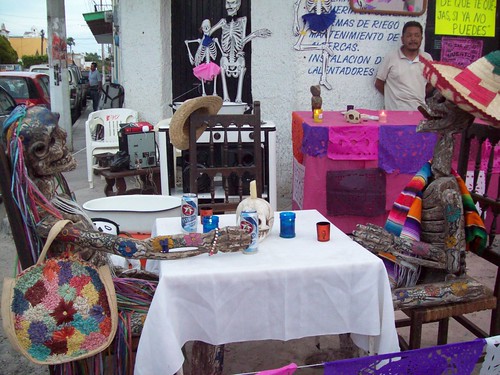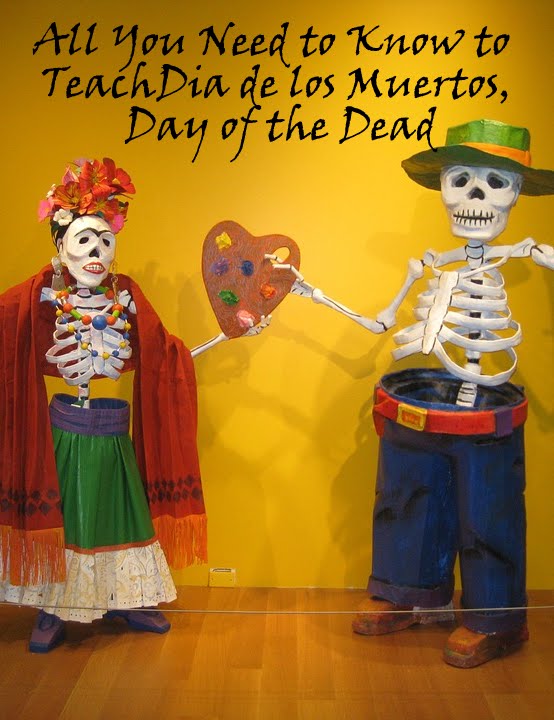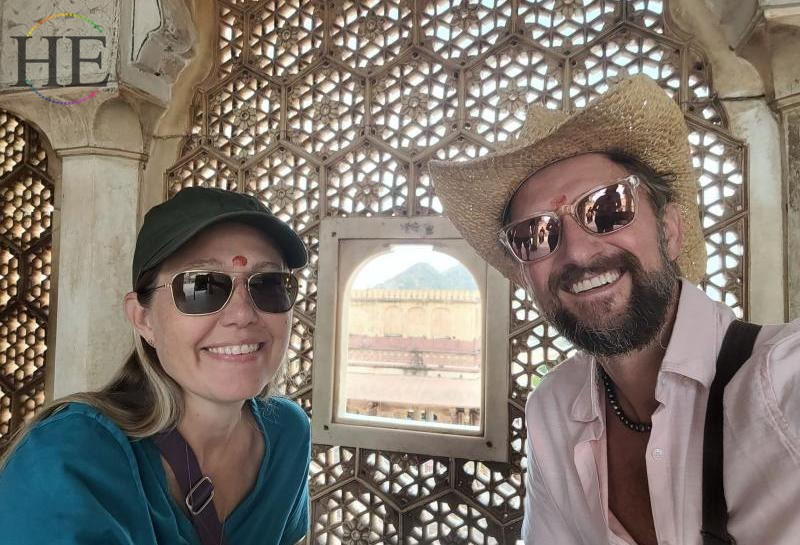“The word death is not pronounced in New York, Paris or in London,
because it burns the lips. The Mexican, in contrast, is familiar with death,
jokes about it, caresses it, sleeps with it, celebrates it; it is one of his
favorite toys and his most steadfast love.”
-Octavio Paz, The Labyrinth of Solitude, 1961.
“Días de los Muertos is an ancient, Mexican and Mexican American religious holiday, with a historically rich tradition that integrates pre-Columbian and Catholic customs. It is often celebrated in Mexico on November 1 and 2 (dates vary by region and may be longer) in connection with the Catholic Holy Days of All Saints’ Day and All Souls’ Day.
For many Latin American countries, it is a time to honor and greet the departed as they make their journey back to be with the living each year. These days are a time for families and friends to gather in celebration of life and death. The circle of life, rather than loss and sorrow, is embraced.” ~ http://www.mexic-artemuseum.org
Dia de los Muertos is actually Dias de los Muertos — the holiday is spread over two days. November 1 is Dia de los Inocentes, honoring children who have died. Graves are decorated with white orchids and baby’s breath. November 2 is Dia de los Muertos, honoring adults, whose graves are decorated with bright orange marigolds. ~ https://education.nationalgeographic.org/resource/what-day-dead/
If you’re teaching this cultural celebration and need resources, look no further.
We’ve discovered the best of the internet for you to utilize in helping students learn about Dia de los Muertos, including:
* Interactive
* Art
* Poetry
* Resources
* Videos
* Printables
Smithsonian Latino Center’s Theater of the Dead
An interactive learning portal – fantastic! I can’t say enough about this fun site.
Mexic-Arte Museum: a PDF guide teaching about the Day of the Dead, culture, establishing Mexican national identity, celebrating Day of the Dead, and Recipes and Art Activities
From the Menello Museum: a detailed PDF lesson plan that includes learning about the history, and then creating an altar, sugar skulls, bread of the dead, and more. Archived here, courtesy of the internet archive.
At Growing up Bilingual, 25 DIY crafts for kids
At picmonkey, canva, or other graphic design sites, you can upload photos of yourself and decorate them with Day of the Dead art for free. Here’s one our daughter made:
Calaveras are satirical Day of the Dead rhyming poems. The Mexican Folk Art Guide has an excellent history of this tradition
The Latin American & Iberian Institute at the University of New Mexico has a first-rate PDF lesson plan for celebrating this holiday, in their K-12 Educator’s Guide, which covers history, culture, contemporary practices, and writing and art activities: “The following thematic guide was created with the hope that it would encourage increased cultural awareness, appreciation and acceptance of Día de los Muertos. The first part of this guide includes a more in-depth introduction to Día de los Muertos. The lesson plans that follow focus on teaching about Día de los Muertos through various literacy and art-based activities. In the process of participating in these lessons and activities, students will better understand the cultural significance and purpose of Día de los Muertos celebrations.”
DayoftheDead.com – outstanding resource!
“In 1987, Mary J. Andrade started a journalistic research project, which began in Janitzio, Michoacan. Since then, Mary has covered a different state of the Mexican Republic each year to gather information and take photographs of a pre-Hispanic tradition known as Day of the Dead— a tradition that has evolved through the centuries and has become an integral element of the Mexican spirit and culture. With the purpose of increasing awareness of this tradition, Mary travels throughout Mexico each October and interviews local inhabitants, anthropologists, and anyone with knowledge of Day of the Dead as it is celebrated in their communities. Through study, she realized the subtle differences in the celebrations among the states of Mexico. Above all, she discovered a deep respect for this age-old tradition.”
ESOL Courses has worksheets for varying ages and language abilities:
Comprehensive K-12 Curriculum Resource Guide, from the Stone Center for Latin American Studies, Tulane University
Mexican Sugar Skull has an extensive teacher page about the Day of the Dead. Included are the history of the holiday, history of sugar skulls, how to make an Ofrenda (altar), how to make sugar skulls, paper decorations, and more:
This is my favorite resource on this list! The Mexican Folk Art Guide shares a great deal of easily accessible information on this celebration, including some beautiful art history: “In 1948 Diego Rivera who considered Posada his artistic father, made the mural Sunday Evening’s Dream http://www.diegorivera.org/dream-of-a-sunday-afternoon-in-alameda-park.jsp in which he represented 400 years of Mexican history. In this masterpiece Rivera depicts the end of an era destroyed by the Revolution war, and the beginning of a new cycle as a modern and more equitable nation.”
And Khan Academy on the painting.
Detail with the artist as a young man (left), the paintier Frida Kahlo (behind him), La Catrina (the Skeleton) and the printmaker, José Guadalupe Posada (right)
El Museo offers a detailed guide that includes traditions in Mexico, celebrations in the US, activities, glossary, and more. Of special interest is the bibliography and webography – it is an excellent resource.
The National Museum of Mexican Art provides downloadable PDFs:
* 100 Años de Posada y su Catrina: Day of the Dead 2013: The 2013 Day of the Dead exhibition was dedicated to the life of the great Mexican printmaker, Jose Guadalupe Posada.The educator guide contains background information on the life and contributions of Posada in both Spanish and English along with resources, a glossary, images and lesson plans. (File size: 10 MB)
* Hanal Pixan: Food for the Souls – Day of Dead 2012: The 2012 Day of the Dead exhibition featured the theme of Hanal Pixan, the name given to Day of the Dead festivities in the Yucatan region of Mexico. The packet features information about the Mayan roots of this holiday and showcases the unique traditions of this region.
Teacher Vision has a section on videos and activities for different K-12 grades, including lesson plans, worksheets, and more.
National Geographic’s Education blog offers links to resources
Our Student Articles on Dia de los Muertos While Living Abroad:
* Dia de los Muertos in Chapala, Mexico, from Joy Whitehead
* Giant Kites, Bright Colors, and a Graveyard: Guatemala’s Day of the Dead, from Anders Bruihler 
Dessert!
Here’s an easy dessert recipe from our Global Cuisines and Kids Editor, My Kids Eat Squid – Crispy Cinnamon Strips and Pumpkin Spice Dip – she’s also listed some useful resources for learning about Mexico’s Day of the Dead, Dia de los Muertos
Teaching Latin America Through Literature shares an extensive curriculum on the holiday, including writing and art activities, ELL activities, and supplementary resources.
Miscositas offers free 60+ page curricula via google drive:
* A thematic curriculum unit about the Day of the Dead for intermediate Spanish students – includes lesson plans, worksheets, and resources for celebrating the Day of the Dead in your classroom. (62 pages)
* A thematic curriculum unit about the Day of the Dead for intermediate ESL/ELA students. This interdisciplinary unit comes with lesson plans, worksheets,
and resources for celebrating the Day of the Dead in your classroom.
Bob Krist has an incredible look at the preparation for and celebration of the Day of the Dead, in Oaxaca.
Oaxaca: The Day of the Dead from Bob Krist on Vimeo.
¡Viva Calaca! is an animation project created by the art director and designer Ritxi Ostáriz, and based on the Mexican Day of the Dead celebration. It’s very creative – and
Lauren Benichou made this short documentary film (her very first) about making, assembling, and decorating sugar skulls.
The Making Of the Sugar Skulls from Lauren [Lo] Benichou on Vimeo.
CGI Animated Shorts: “Dia De Los Muertos” – beautifully animated, and heart felt, short film about a little girl who visits the land of the dead, where she learns the true meaning of the Mexican holiday, Dia de los Muertos.Student Academy Award Gold Medal winner, 2013!!
Muy Bueno has a fun Day of the Dead Sugar Skull Decorating Party video, with tips:
From the Peabody Museum at Harvard:
* Harvard Divinity professor David Carrasco on the bold colors and favorite images of papel picado, the cut paper banners popular during Día de los Muertos (Day of the Dead) and other celebrations.
* What is the origin of papel picado, the cut paper banners popular during Día de los Muertos (Day of the Dead) and other celebrations? Harvard Divinity professor David Carrasco explains two theories.
* The story of Xolotl, the supernatural dog who returned from the underworld, as told by Harvard Divinity professor David Carrasco in front of the Day of the Dead altar.
Masks
Sugar skull printable
Skull pages with more detail
A variety of printables for learning
What are your favorite resources for teaching Dia de los Muertos, Day of the Dead?
Books
I loved reading Reina Telegemeier‘s graphic novel, Ghosts. It’s all about celebrating Dia de los Muertos! Take a look at the book trailer.
Note: this article was published in 2016 and updated in 2024



